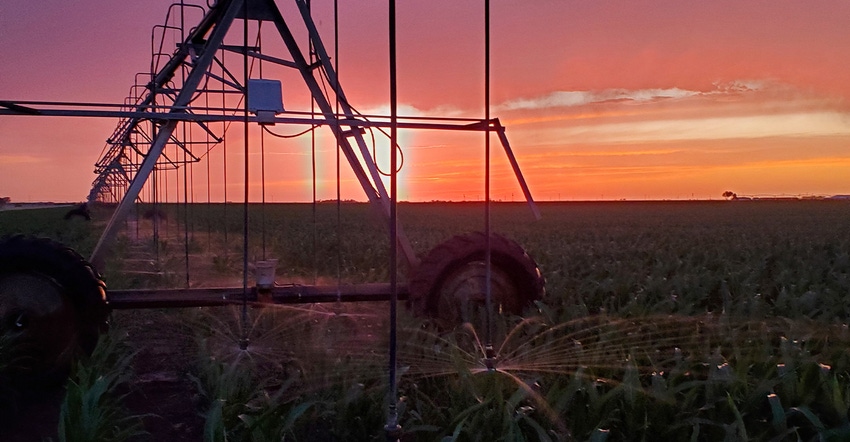
Limited and declining well capacities, droughts, localized water quality concerns, and other technical and regulatory issues present significant challenges for agricultural irrigators in Texas.
It’s especially challenging in the Texas High Plains where agricultural irrigation accounts for more than 90% of groundwater withdrawals, says Texas A&M AgriLife Research and Extension Service Engineer Dana Porter, Lubbock.
 Texas A&M AgriLife Research and Extension Service Engineer, Dana Porter, Lubbock. (Photo by Robert Suddarth Photography)
Texas A&M AgriLife Research and Extension Service Engineer, Dana Porter, Lubbock. (Photo by Robert Suddarth Photography)
Porter, who also serves as Extension program leader and associate department head in the Department of Biological and Agricultural Engineering, discussed the challenges and strategies to save water at the December Texas Plant Protection Association annual meeting in Bryan, Texas.
“The Texas State Water Plan, integrating regional water plans developed with input from local water user groups throughout the state, recommends agricultural water conservation strategies and technologies to help meet water needs in the future,” Porter said.
The need is real. The Texas High Plains accounts for approximately 78% of the state’s irrigated acreage on 13% of the state’s cropland. The area accounts for 50% of the state’s agricultural crop market value, or more than $12.8 billion annually.
“We have strategies in place to save water,” Porter said. Options include irrigation scheduling, equipment changes, soil management, advances in plant breeding, conversion to dryland farming, changes in crop type, and changes in crop variety.
Strategies will vary across the state and across the region, she added. Some projects will qualify for assistance through programs such as the USDA Natural Resources Conservation Service Environmental Quality Incentives Program (EQIP). “That could be a major factor in adopting water-saving strategies,” Porter said.
“Regardless of the specific tools selected, optimizing crop water use depends on several factors. Those include managing and maintaining the irrigation system, applying knowledge of crop water requirements and soil-water-plant-atmosphere relationships, and managing total crop water in the context of integrated crop management.”
Porter said landowners or producers face economic, climate and crop, operation-specific, strategy efficacy, policy, and technical considerations as they explore water conservation options.
Porter explained that numerous barriers to making improvements to reduced energy use or to conserve water exist. According to the 2018 USDA Census of Agriculture, those barriers include:
Making an investment in improvements is not a priority;
Risk of reduced yield or poorer crop quality;
Physical field/crop conditions limit system improvements;
Improvements will not reduce costs enough to cover installation expenses;
Cannot finance the improvements;
Landlord will not share in the cost;
Uncertainty about future availability of water;
Will not be farming the operation long enough to justify improvement; and
Improvements will increase management time or cost.
Making strides
Farmers have made significant strides across the region, Porter said. “Producers in the High Plains have adopted highly efficient advanced irrigation technologies. These include Low Energy Precision Application (LEPA), Low Elevation Spray Application (LESA), Mid-Elevation Spray Application (MESA), Low Pressure in Canopy (LPIC), Precision Application-Residue Managed (PARM), micro-irrigation and sub-surface irrigation.”
She said farmers can enhance these improvements with even more efficient management. “Farmers may use irrigation scheduling tools,” Porter said. They also can take advantage of “locally relevant applied research programs that address local issues. Collaboration among university research, groundwater conservation districts, USDA-ARS, and USDA-NRCS can help identify and address issues and coordinate and facilitate technology transfer.”
More options are on the way, Porter said. “We are seeing advancements with current and emerging technology. Irrigation equipment manufacturers, universities, USDA-ARS, and collaborations among these groups are further integrating wireless sensor technologies, remote sensing, advanced GPS technologies, and machine learning/artificial intelligence to develop ‘smart’ and IoT-enabled control systems for irrigation.”
Examples include Netafim, Valley/AgSense, Lindsay Zimmatic FieldNet, Reinke ReinCloud, and Autonomous Pivot. Also, USDA-ARS is working on the Irrigation Scheduling Supervisory Control and Data Acquisition (ISSCADA). University research and Extension programs are also working on new technology.
“Emerging technologies and research-based management strategies offer potential solutions to address or mitigate agricultural irrigation challenges,” Porter said. “But adoption and effectiveness of the recommended strategies will depend on factors specific to farm operations.”
About the Author(s)
You May Also Like






